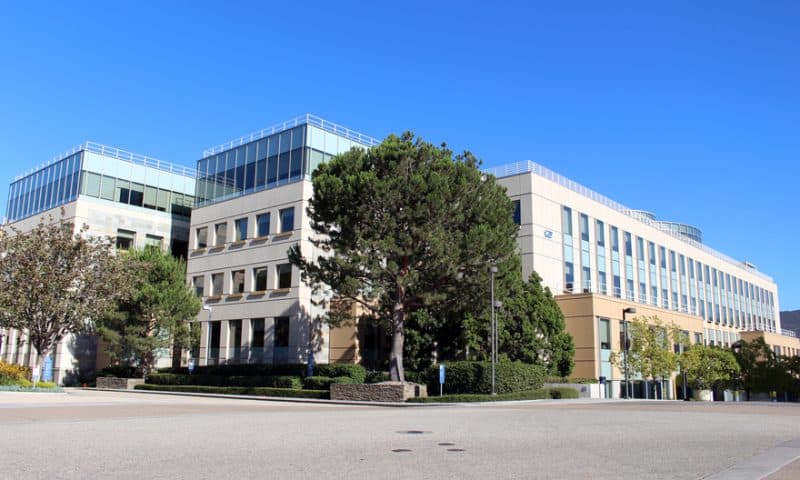As regulators across the world make their way through the submission for what could be the first approved KRAS inhibitor, Amgen is unveiling its biggest data set yet in patients with non-small cell lung cancer (NSCLC). The drug, sotorasib, curbed tumor growth in 81% of patients and shrank tumors in 37% of them.
The phase 2 data, to be presented virtually on Friday at the World Conference on Lung Cancer, come from 126 patients with NSCLC whose tumors harbor KRAS G12C mutations and whose cancer has gotten worse despite trying as many as three prior lines of therapy. All 126 patients received 960 mg once each day until their cancer progressed.
Besides shrinking tumors in more than one-third of patients, sotorasib eliminated all signs of cancer in three patients (2%). It staved off tumor growth for a median of 6.8 months and patients responded to the treatment for a median of 10 months. The numbers are similar to those seen from a smaller group of patients from a phase 1 study of sotorasib, where 32% of patients saw their tumors shrink and 88% had their tumors stop growing.
“At ESMO, we peeled out all the lung cancer patients from a larger phase 1 study and there was some heterogeneity in those patients—it was 59 patients treated at different dose levels,” Greg Friberg, Amgen’s vice president of global oncology development, said. “We were really pleased to see responses across the different cohorts… Of course, the goal of oncology is to take that and run a dedicated cohort asking the question, is it consistent? The data we’re reporting now is one step closer to where we want to be.”
Jefferies analyst Michael Yee agreed. “This was expected to be positive already so this is just confirmation the data is good and is already under review by the FDA, and as the prior top-line disclosure by the co stated the efficacy is ‘consistent’ with phase 1 results,” he wrote in a note to clients on Thursday.
Right now, the patient group lacks a targeted therapy, even as patients with other mutations benefit from tailored treatments. And that’s the void Amgen is hoping to fill.
“6.8 months compares quite favorable to what we typically think of as two to four months for a drug like docetaxel, and that’s before we get into side effect profiles,” Friberg said. “Essentially, what we’re answering is this drug looks like it has consistent, deep, durable responses and very promising survival numbers at this point. We are hopeful this is the beginning of our opportunity to deploy the drug into different settings.”
Part of that plan includes testing sotorasib in earlier lines of therapy and in combination with one or more cancer drugs. And success in those arenas requires a good safety profile.
About two-thirds of patients reported side effects, most of which were mild to moderate. The most common side effects were diarrhea, affecting 31% of patients; nausea, striking 19%; and elevated liver enzymes, afflicting 15%. There were no treatment-related deaths, but 7% of the patients quit the study because of side effects and one-fifth of them needed dose modifications.
“With the unfortunate baggage of prior therapies those patients are living with, as well as (the effects of) their tumor, from that standpoint, what we saw in the study was a side effect profile that looked consistent with phase 1,” Friberg said, adding that the drug’s safety profile was promising compared with docetaxel and other treatments.
Over time, Amgen and the investigators have learned how to manage side effects so that patients can remain on treatment, Friberg said.
Amgen is seeking approval for sotorasib as a second-line treatment for this patient group in the U.S., U.K., European Union, Canada, Australia and Brazil. Yee expects a speedy OK.
“We are positive on ‘fast FDA approval’ by spring/summer and strong uptake—but big focus and stock move is contingent on KRAS ‘combo’ data in lung, etc., which is maybe at ASCO 2021 to move consensus estimates across the Street,” he wrote.
Amgen is also testing the drug against docetaxel in a randomized phase 3 study in previously treated patients, but it’s also conducting a single-arm phase 2 study in the first-line setting to figure out which of those patients will benefit the most from sotorasib as a single agent. And the company is also testing 10 different combinations featuring sotorasib in an adaptive study that will allow it to quickly move into phase 2.
Those combinations include antibodies and kinase inhibitors that target EGFR, as well as SHP2 inhibitors, MEK inhibitors and PD-1 blockers, David Hong, M.D., said in a previous interview. Hong, a professor of investigational cancer therapeutics at MD Anderson Cancer Center, presented the phase 1 data for sotorasib virtually at the European Society for Medical Oncology meeting in September.

